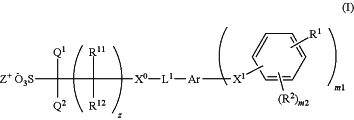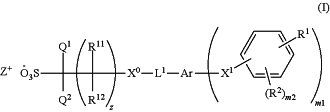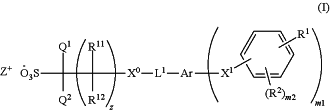| CPC G03F 7/0045 (2013.01) [C07C 25/02 (2013.01); C07C 303/32 (2013.01); C07C 309/06 (2013.01); C07C 309/10 (2013.01); C07C 309/11 (2013.01); C07C 309/17 (2013.01); C07C 309/24 (2013.01); C07C 381/12 (2013.01); C07D 307/93 (2013.01); G03F 7/0382 (2013.01); G03F 7/0397 (2013.01); G03F 7/30 (2013.01); G03F 7/38 (2013.01); C07C 2603/74 (2017.05)] | 11 Claims |
|
1. A salt represented by formula (I):
 wherein, in formula (I),
Q1 and Q2 each independently represent a fluorine atom or a perfluoroalkyl group having 1 to 6 carbon atoms,
R11 and R12 each independently represent a hydrogen atom, a fluorine atom or a perfluoroalkyl group having 1 to 6 carbon atoms,
z represents an integer of 0 to 6, and when z is 2 or more, a plurality of R11 and R12 may be the same or different from each other,
X0 represents *—CO—O—, *—O—CO—, *—O—CO—O— or *—O—, and * represents a bonding site to C(R11)(R12) or C(Q1)(Q2),
L1 represents a single bond or *-L2-CO—O—, wherein L2 represents a cyclic hydrocarbon group having 3 to 18 carbon atoms or a group obtained by combining a cyclic hydrocarbon group having 3 to 18 carbon atoms with an alkanediyl group having 1 to 4 carbon atoms, the cyclic hydrocarbon group may have a substituent, —CH2— included in the cyclic hydrocarbon group may be replaced by —O—, —S—, —CO— or —SO2—, —CH2— included in the alkanediyl group may be replaced by —O— or —CO—, and * represents a bonding site to X0,
Ar represents an aromatic hydrocarbon group having 6 to 18 carbon atoms which may have a substituent,
X1 represents an oxygen atom or a sulfur atom,
R1 represents a halogen atom or a haloalkyl group having 1 to 12 carbon atoms,
R2 represents a halogen atom, a hydroxy group, a haloalkyl group having 1 to 12 carbon atoms or an alkyl group having 1 to 12 carbon atoms, and —CH2— included in the haloalkyl group and the alkyl group may be replaced by —O— or —CO—,
m1 represents an integer of 1 to 6, and when m1 is 2 or more, a plurality of groups in parentheses may be the same or different from each other,
m2 represents an integer of 0 to 4, and when m2 is 2 or more, a plurality of R2 may be the same or different from each other, and
Z+ represents an organic cation.
|
|
3. A salt represented by formula (I):
 wherein:
Q1 and Q2 each independently represent a fluorine atom or a perfluoroalkyl group having 1 to 6 carbon atoms,
R11 and R12 each independently represent a hydrogen atom, a fluorine atom or a perfluoroalkyl group having 1 to 6 carbon atoms,
z represents an integer of 0 to 6, and when z is 2 or more, a plurality of R11 and R12 may be the same or different from each other,
X0 represents *—CO—O—, *—O—CO—, *—O—CO—O— or *—O—, and * represents a bonding site to C(R11)(R12) or C(Q1)(Q2),
L1 represents a single bond or a hydrocarbon group having 1 to 28 carbon atoms which may have a substituent, and —CH2— included in the hydrocarbon group may be replaced by —O—, —S—, —SO2— or —CO—,
Ar represents an aromatic hydrocarbon group having 6 to 18 carbon atoms which may have a substituent,
X1 is an oxygen atom,
R1 represents a halogen atom or a haloalkyl group having 1 to 12 carbon atoms,
R2 represents a halogen atom, a hydroxy group, a haloalkyl group having 1 to 12 carbon atoms or an alkyl group having 1 to 12 carbon atoms, and —CH2— included in the haloalkyl group and the alkyl group may be replaced by —O— or —CO—,
m1 represents an integer of 1 to 6, and when m1 is 2 or more, a plurality of groups in parentheses may be the same or different from each other,
m2 represents an integer of 0 to 4, and when m2 is 2 or more, a plurality of R2 may be the same or different from each other, and
Z+ represents an organic cation.
|
|
7. A resist composition comprising an acid generator comprising a salt represented by formula (I), and a resin having an acid-labile group:
 wherein, in formula (I),
Q1 and Q2 each independently represent a fluorine atom or a perfluoroalkyl group having 1 to 6 carbon atoms,
R11 and R12 each independently represent a hydrogen atom, a fluorine atom or a perfluoroalkyl group having 1 to 6 carbon atoms,
z represents an integer of 0 to 6, and when z is 2 or more, a plurality of R11 and R12 may be the same or different from each other,
X0 represents *—CO—O—, *—O—CO—, *—O—CO—O— or *—O—, and * represents a bonding site to C(R11)(R12) or C(Q1)(Q2),
L1 represents a single bond or a hydrocarbon group having 1 to 28 carbon atoms which may have a substituent, and —CH2— included in the hydrocarbon group may be replaced by —O—, —S—, —SO2— or —CO—,
Ar represents an aromatic hydrocarbon group having 6 to 18 carbon atoms which may have a substituent,
X1 represents an oxygen atom or a sulfur atom,
R1 represents a halogen atom or a haloalkyl group having 1 to 12 carbon atoms,
R2 represents a halogen atom, a hydroxy group, a haloalkyl group having 1 to 12 carbon atoms or an alkyl group having 1 to 12 carbon atoms, and —CH2— included in the haloalkyl group and the alkyl group may be replaced by —O— or —CO—,
m1 represents an integer of 1 to 6, and when m1 is 2 or more, a plurality of groups in parentheses may be the same or different from each other,
m2 represents an integer of 0 to 4, and when m2 is 2 or more, a plurality of R2 may be the same or different from each other, and
Z+ represents an organic cation.
|
|
11. A method for producing a resist pattern, which comprises:
(1) a step of applying the resist composition according to claim 7 on a substrate,
(2) a step of drying the applied resist composition to form a composition layer,
(3) a step of exposing the composition layer,
(4) a step of heating the exposed composition layer, and
(5) a step of developing the heated composition layer.
|